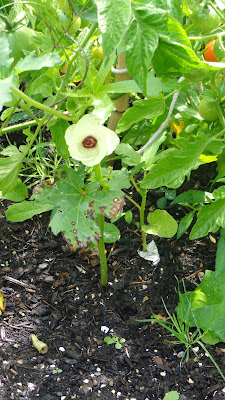Okra seeds were planted 5/26 in raised bed. The only variety I tried was Clemson Spineless. I chose that variety due to its reported short season capability. I also planted okra seeds in newspaper lined containers on 5/26. Those germinated faster than the ones in the raised bed.
 |
| Okra seedlings 6/4 |
The ground was still fairly cool. I did not take the temperature. I should have. It was warm enough for tomato plants, which I already had growing in this same raised bed.
I read that okra can't be transplanted. That's not true at all. The plants that I started in containers grew faster and more vigorous, compared to the ones planted directly in the ground. The container-started ones were the only plants that bore pods for me.
 |
| 8/10 |
 |
| 8/10 |
 |
| 8/10 |
Below are other okra plants started at the same time, and a bit of a closer shot of the flower. Behind it are ripening tomatoes.
The first pod was elongating on 8/24.
I harvested the first pods on 9/4. I harvested a few more 1 and 2 weeks later. After that the plants deteriorated in the cooler days and nights.
Lessons learned.
1. They did better as container starts. So plan to start that way again.
2. Clemson may or may not be the most suitable variety. So plan to trial several varieties next year. Possibly also Clemson Spineless if I have seeds and if they keep a year.
3. They need more warmth than I can get in the unprotected raised beds. Use a row cover or poly tunnel, patterned after the rebar / PVC pipe method I used this year for other plants. I should use a lower, removable version for easier access and more workable. Place the cover at least a few weeks early to warm the soil, leave in place until days and nights are warm. Replace it again in September when days and nights cool off.
4. Take the soil temperature.
Okra Varieties to try 2014:
Baby Bubba From Burpee, a hybrid, dwarf variety. 53 days. Can be grown in containers as well - warmer soil. 3 to 4 feet tall.
Emerald Okra From Victory Seeds. 55 days.
Dwarf Green Long Pod Okra. From Victory Seeds. 52 days. Plant heights 24 to 30 inches tall, and reported to grow in Northern gardens. I want the shorter size in case they do well, but need cover later in the season.
Clemson Spineless. Again. 55 days, grow 3 to 5 feet tall.
 |
| 8/24 |
 |
| 9/5 |
Link to "All about okra"
Oregon State University suggests a plastic mulch and wind protection. I can do that. They also state "Night temperatures should be above 55 F for good growth.
Minimum soil temperature for germination is 60 F. Optimum soil temperature range is 75-90 F."
In addition, OSU article states: " Sow seeds in 2-inch pots or cell-packs, 3 seeds per pot, 1/4 inch deep, 4-5 weeks ahead of transplanting. Thin to 1 plant per pot or cell." So the not-transplanting info is not accurate.
On mulch, they state: "Black plastic mulch may increase soil temperatures, will control weeds, and conserve moisture, increasing yield and earliness... it is critical...the soil surface be smooth and...the plastic adhere to the soil surface. ...Clear plastic mulch is very effective at increasing soil temperature but does not control weeds." Other plastics are discussed. Black or clear aplastic mulch might help tomatoes and peppers too. They discuss using row cover or other options for tunnels: "...row covers may be used for 4-8 weeks immediately after transplanting...removed when plants begin to flower to permit proper pollination. Row covers can increase heat unit accumulation by 2-3 times over ambient...Soil temperatures and root growth can also be increased under row covers as are early yields, and in some cases total yields."
So with some research, and the raised bed infrastructure in place, I hope to have a better okra crop next year.
